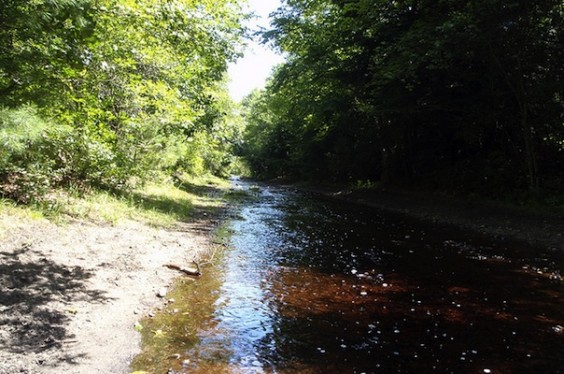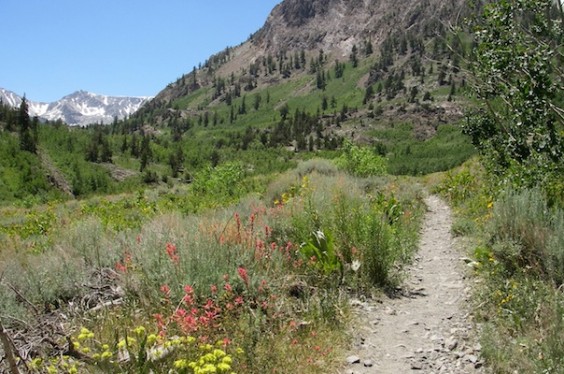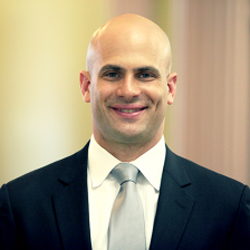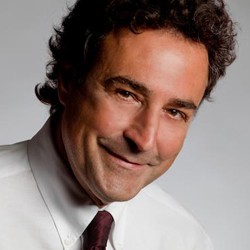Saturday, June 29, 2013
Kansas judge blocks portions of state's new abortion law
Friday, June 28, 2013
Less care for rural US breast cancer patients
Rural US breast cancer patients are less likely than those in cities to receive recommended radiation therapy after a lumpectomy, a new study finds.
Inside the mind of a murderers
Research shows that impulsive murderers are much more mentally impaired than those who kill strategically.
Thursday, June 27, 2013
Libya defence minister removed after Tripoli clashes
Mandela: what is a ventilator?
43 Hidden Hikes to Try This Summer
43 Hidden Hikes to Try This Summer
Sure, hiking the Appalachian Trail is an experience no one ever forgets. But the United States is a pretty big place, with tons of opportunities for hiking and camping in spots that don’t attract millions of tourists every year. For those who like the feel of going where (almost) no man has gone before, or for those looking for a little peace and solitude, we’ve got just the solution.
This list includes 43 trails that are “hidden,” either because they’re physically hard to find or because not many people know they exist. Newbie hikers can take a stab at some of the mile-and-under strolls, while more experienced folks will love the long-distance treks. We’re talking breathtaking views of the sunrise, chilling with local wildlife (please don’t feed the animals!), and the chance to learn more about the natural environment. So lace up those hiking boots, buy a map, and most importantly, pack a sense of adventure.

1. The Walls of Jericho, Huntsville, Alabama
Length: 3.5 miles
Skill level: Difficult
This trail isn’t too far from Huntsville, but it feels like it’s a world away from the hustle and bustle of the city. So slap on those waterproof boots and prepare to feel the burn as you trek downhill and then all the way back uphill through a muddy trail marked by caves and waterfalls. Legend has it a traveling minister named the hike more than two centuries ago when the nearly 200-foot walls reminded him of a cathedral.
2. Hidden Creek Trail, Soldotna, Alaska
Length: 1.5 miles
Skill level: Easy
Okay, so the first part of this trail isn’t so spectacular. But hikers say once you get to the loop, you’ll find Hidden Creek (literally hidden in a grassy marsh), glistening Skillak Lake, and a breathtaking view of the Kenai Mountains — no manmade stuff in sight. It’s a pretty family friendly hike, too, since it’s relatively easy and there’s a bunch of fishing spots around the creek. Looking for more adventure? Start on one of the other trails off Skillak Lake Road.
3. Girdner Trail, Sedona, Arizona
Length: 4.5 miles
Skill level: Moderate
Ditch the daily grind and instead take a tour through Arizona’s amazing natural landscape. Hikers start out passing through lush forests and juniper groves with views of sandstone cliffs, then walk underneath sycamores until they reach a pink-tinged rockscape.
4. Dripping Cave Trail, Orange County, California
Length: 0.75 miles
Skill level: Easy
Take a hike through history on this multi-use route (open to hikers, bikers, and equestrians). The trail passes right by Dripping Cave, an area that was likely used as a refuge for Native American hunter-gathers and as a hideout for the Juan Flores gang of robbers. It’s one small part of Aliso and Wood Canyons Wilderness Park, a designated wildlife sanctuary that sprawls across 30 miles of trails and features a whole range of endangered animal and plant species.
5. Mount Galbraith, Golden, Colorado
Length: 4.25 miles
Skill level: Moderate
There’s never a dull moment on this four-mile stretch that features trails, forests, and meadows. There will likely be some heavy breathing on the hike up to the loop, but once you get there, it’s an easy stroll with breathtaking views on both sides. Those craving more adventure after the hike ends can continue on to (possibly more well-known) trails in Golden Gate Canyon and Eldorado Canyon State Parks.
6. Beaver Brook Trail, Milford, Connecticut
Length: 1.3 miles
Skill level: Easy
For those New Englanders looking for a way to pass a pleasant afternoon, consider crossing the trails and the footbridge across the wetlands in Beaver Brook. And don’t forget to bring the binoculars, since this is the perfect spot for bird watching. The summer’s also a good opportunity for fishing in the brook. Need some additional exercise? Continue on to the Mondo Pond paths.
7. Creek Trail, Santa Rosa Beach, Florida
Length: 4 miles
Skill level: Varies
We love Disney World, but not all of Florida’s that crowded. Forgo the fifteenth ride on Space Mountain and check out this combination of forest footpaths, paved trails, and bridges over wetlands. Don’t worry about bringing a portable fan, either: A canopy of trees (including the “titi” tree) keeps things cool throughout the trek. (Note: Parts of the trails are also suitable for biking.)
8. Benton MacKaye Trail, Fannin County, Georgia
Length: 300 miles
Skill level: Difficult
Say “so long” for at least a few weeks if you plan to hike the whole thing. This 300-mile trail passes through the backcountry of North Carolina, Georgia, and Tennessee, and includes parts of the Appalachian Mountains. There are also lots of options for shorter hikes along the way, passing through several federally designated Wilderness Study Areas. Try hiking from Three Forks to Springer Mountain, if only to marvel at the views of the southern Georgia Mountains at the end.
 9. Mount Olomana, Kailua, Hawaii
9. Mount Olomana, Kailua, Hawaii
Length: 3 miles
Skill level: Difficult
Well, at least this hike was pretty unknown until it made The New York Times a few years ago. The trip involves climbing three separate peaks, but most hikers just do the highest peak, totaling 1,643 feet. The chance to peer down through the clouds at the very top makes the whole trip up worth it.
10. White Cloud Mountains, Custer County, Idaho
Length: 32.5 miles
Skill level: Difficult
The Sawtooth Mountains usually steal the spotlight, but this lesser-known range offers equal opportunities for scenic long-distance treks. Forty years ago, a proposal to create a national park where the mountains currently stand failed. Today, it’s a place for ambitious hikers to catch a glimpse of the animal kingdom, including elk, mountain goats, bighorn sheep, black bears, and gray wolves.
11. Big Woods Trail, Vermilion County, Illinois
Length: 1.5 miles (combined with Fox River Trail)
Skill level: Difficult
The Big Woods Trail slinks through American Indian trails and the ravine system, and ends with a photo op at the observation tower. It’s one of the many paths in Forest Glen Preserve, which includes other routes for backpackers, day-hikers, and those with handicaps.
12. Heron Rookery, Chesterton, Indiana
Length: 2.4 miles
Skill level: Moderate
Apparently, even Indiana natives aren’t so familiar with this trail, nestled among farm fields. Fishing aficionados can check out the Little Calumet River; everyone else can take in the beautiful wildflowers and watch the Great Blue Herons feeding in their natural habitat.
13. Shellrock River Greenbelt and Preserve, Cerro Gordo County, Iowa
Length: 7.5 miles
Skill level: Moderate
Leap through limestone bluffs and journey through woods, meadows, and ponds while viewing all sorts of wildlife. And don’t forget the PB&J: There’s a picnic area along the way.
14. Indian Creek Bike and Hike Trail, Overland Park, Kansas
Length: 17 miles
Skill level: Moderate
Hikers, bikers, joggers, and dog-walkers are all welcome on this flat, paved trail. Veteran hikers say the path feels more woodsy than urban, and it’s generally pretty empty, especially on weekdays. The trail also connects to parks with ball fields, tennis courts, and playgrounds.
15. Blair Spring Hollow Trail, Kentucky
Length: 1.2 miles
Skill level: Easy
It’s a pre-Halloween spook-fest on this trail, part of Mammoth Cave National Park which features more than 300 miles of underground passages (and possibly more, still unexplored). While guided tours of the caves below ground attract lots of tourists, this above-ground trail doesn’t see much action throughout the year, so hikers can feel free to mosey in peace and gaze at the magnolia trees lining the path.
16. Northern Section of the Appalachian Trail, Oxford County, Maine
Length: 33 miles
Skill level: Difficult
It takes about four days to hike this last stretch of the Appalachian Trail, left pretty much empty by tourists who flock instead to sites such as Baxter State Park. The hike is a postcard-picture-worthy journey up and down mountains, around lakes, and through thick spruce forests.
17. Chesapeake Wine Trail, Eastern Shore, Maryland
Length: Varies depending on tour
Skill level: Easy
Okay, so drinking out of a flask while hiking is generally not advisable. But sipping from a wine glass? So much classier. And we’re not talking about touring those famous wineries in California — there are lots of less well-known wine trails on the Eastern Shore. Visit St. Michael’s Winery, the biggest one on this trail, for some tastings, then work off all that vino by picking from apple, peach, pear, and plum trees.
 18. Midstate Trail, Worcester County, Massachusetts
18. Midstate Trail, Worcester County, Massachusetts
Length: 92 miles
Skill level: Moderate
Revamped in 1972, this trail is the product of teamwork between government officials and outdoorsy volunteers. Today, hikers can make the trek from Rhode Island to New Hampshire, winding their way through fields, forests, hills, and towns along the way. Of course, choosing just a portion of the trail to hike is also more than acceptable.
19. Minong Ridge, Isle Royale, Michigan
Length: 37.3 miles
Skill level: Difficult
Leave the masses behind and take a pretty much private tour through trees, forests, and campsites by the lake. History buffs will jump at the chance to see a copper mine from the 1890s, while animal lovers can check out the variety of bird species. And better remember to pack some bravery: Wolves are known to make a rare appearance on this trail.
20. Blind Ash Bay Trail, International Falls, Minnesota
Length: 2.5 miles
Skill level: Moderate
Wind your way through this rocky trail, part of Voyageurs National Park in northern Minnesota. But don’t look down at your feet the whole time — the majestic forest surrounding you is beautiful. Return in the winter for snowshoeing!
21. Meremac Wilderness Trail, Sullivan, Missouri
Length: 8.5 miles
Skill level: Moderate
Deer, turkey, and squirrels, oh my! Our furry and feathery friends will likely be the only company we’ll have on the longest hike in Meramec State Park. It’s a sightseer’s paradise, complete with caves, springs, buffs, glades, and rock ledges. Choose to hike the whole thing in one day or stay overnight at one of the backpack camps along the trail.
22. Siyeh Bend to Logan Pass, Kalispell, Montana
Length: 92 miles
Skill level: Difficult
Hike this less-trodden trail (part of Glacier National Park) in one long trip, or break it up into smaller treks. Either way, it’s a great chance to camp at a site surrounded by waterfalls and spot some wildlife. But beware: Bears have been known to make an appearance on the trail.
23. Falls in the River Trail, Pittsburg, New Hampshire
Length: 2 miles
Skill level: Moderate
This family-friendly trail runs beside the Connecticut River, and the sounds of rushing water greet hikers as they make their way along the path. Wildlife and waterfowl call this place home; otherwise you’ll find few distractions from peace and solitude.
24. Pochuck Mountain, New Jersey
Length: Variable
Skill level: Difficult
Talk about living history — the rocks that form this mountain are over a billion years old. And summiting them is no small challenge, either: The mountain peak stretches 1,149 feet into the sky. The name “Pochuck” literally means “out-of-the-way place” in the Lenape language, but don’t be fooled: The Appalachian trail runs over the top of the mountain, so this trail does see a bit more foot traffic than some of the other hikes on this list.
25. Gila Wilderness, Catron County, New Mexico
Length: 35 miles
Skill level: Difficult
Set aside a few days to make this challenging trek. Some of the main attractions include hoodoos (tall columns of rocks), a 700-year-old cliff dwelling, and a hot spring.
26. Walking Dunes Nature Trail, Napeague, New York
Length: 0.75 miles
Difficulty: Easy
If you like makin’ love at midnight, in the duuuunes of Long Island, this trail is for you. Or if you’re just into spectacular views as seen from between 40-foot-tall dunes, we recommend checking this place out.
27. Linville Gorge Wilderness, Pisgah National Forest, North Carolina
Length: 22 miles
Skill level: Difficult
It takes at least three days to make the full circuit, so prepare for some hardcore camping. But it’s hard to prepare for what it feels like to stand on the edge of a cliff and look down at the gorge below. A thicket of hemlock stands, rhododendrons, and mountain laurel, plus a waterfall, make this trail feel simply magical.
28. Caprock Coulee Trail, Medora, North Dakota
Length: 4.3 miles
Skill level: Moderate
Everyone’s heard of Teddy Roosevelt, but his namesake park is less commonly known. Hikers on the Caprock Coulee Trail wend their way through water gulches and ascend a hill to a grassy butte, where they can marvel at the spectacular views before making their way back down.
29. Nelson Kennedy Ledges State Park, Garrettsville, Ohio
Length: 0.5-1 mile
Skill level: Varies (easy to difficult)
Daredevils are welcome (and those with a fear of heights, beware): These trails are marked by a series of rugged cliffs. Four different trails are designed for four different skill levels, so anyone can try their hand (er, foot) at hiking. Tables and grills are provided — reward yourself at the end of a long trek with a little picnic.
 30. McGee Creek Natural Scenic Recreation Area Trail System, Atoka, Oklahoma
30. McGee Creek Natural Scenic Recreation Area Trail System, Atoka, Oklahoma
Length: 23 miles (total)
Skill level: Moderate
These trails are designated a “quiet-water zone,” and visitors need a (free) permit to hike there. The trail system is also home to a bunch of wildlife, so expect some four-legged company on your journey.
31. Eagle Cap Wilderness, Enterprise, Oregon
Length: 41 miles
Skill level: Difficult
Beat the heat and hike by a serene lake surrounded by Indian paintbrush, sego lilies, and bluebell flowers (they bloom in July). Most hikers visit the Wonderland trail, so leave the masses behind and check out the 5,000-foot tall granite peaks that dot this hike hidden in Oregon’s largest wilderness.
32. Dingmans Falls Trail, Pike County, Pennsylvania
Length: 0.4 miles
Skill level: Easy
Don’t go chasin’ waterfalls… Unless you’ve just made it across the footbridge at Dingman’s Falls, some of the highest falls in Pennsylvania. Hemlocks and rhododendrons make this hike more of a walk through a natural wonderland.
33. Guignard Clay Quarry Loop Trail, Cayce, South Carolina
Length: 2.7 miles
Skill level: Easy
Though this trail is pretty close to Columbia, it’s the literal path less traveled, with minimal traffic throughout the year. The overgrown wetlands area actually used to be a quarry for a brick plant; today it’s a spot where hikers and their pooches can come for some solitude.
34. Sage Creek Unit, Rapid City, South Dakota
Length: 20 miles
Skill level: Difficult
There aren’t actually any trails in the Badlands’ Sage Creek Unit, so hikers need to develop a good sense of direction before trekking along this route. The key is to make like the animals, following a bison path to another area where deer, antelope, and raptors like to play. Summer’s the perfect time to visit, especially for a more romantic experience — flowers bloom in June and the Perseid Meteor Shower is visible in August.
35. Spruce Flats Falls and Chestnut Top Wildflowers, Townsend, Tennessee
Length: 2 miles
Skill level: Difficult
While the gorgeous waterfalls are known to attract a bit of a crowd, the trail that leads there is more of a solo experience. The hike is only two miles long, but the uphill climb makes it a pretty intense workout.
36. McKittrick Canyon to Pine Springs, Culberson County, Texas
Length: 24.1 miles
Skill level: Difficult
This trail, part of Guadalupe Mountains National Park, keeps hikers on their toes, winding through terrain as varied as desert lands, canyons, and mountains. Camp overnight and snag a sunset view of the highest peaks in the McKittrick Ridge. The only (potential) problem is there’s no water available, so backpackers have to lug their own.
37. Lee Pass Trailhead to East Rim Trailhead, Springdale, Utah
Length: 47 miles
Skill level: Difficult
A painter’s paradise, this trail in Zion National Park features the orange and red Kolob Canyons and some labyrinth side canyons made of white and red sandstone. The views from the top of canyon walls make the whole experience thrilling, and the best part is waking up early to watch light spread over the land.
38. Eshqua Bog Natural Area, Hartland, Vermont
Length: 1 mile
Skill level: Easy
When the local botanic gardens just don’t cut it, travel instead to see rare wildflowers (marigolds, bunchberry, lady’s slipper orchids!) on this trek through Vermont’s wetlands. A boardwalk over a bog makes up part of the trail, so it’s a bit easier on the feet than some of the other hikes on this list.
39. Crabtree Falls, Nelson County, Virginia
Length: 4.4 miles
Skill level: Options for easy, moderate, and difficult
Look up! The beautiful waterfall at the end of this uphill hike is the highest vertical-drop cascade east of the Mississippi River. Those afraid of heights (or who really have to pee) can take the trail past a series of lower falls.
40. Squak Mountain Connector Trail, Seattle, Washington
Length: 0.7 miles
Skill level: Moderate
The name “Squak Mountain” comes from the sound of the herons that visit here during the spring and fall. Any time of year, it’s a great place to bring the fam and even the dog for an afternoon of peace, solitude, and the chance to take in the beauty of the natural landscape.
41. Turkey Run Park, McLean, Virgina
Length: 2.25 miles
Skill level: Easy to moderate
This easy-to-miss collection of trails makes up part of the Potomac George ecosystem, and connects to larger public trails. It’s a journey through a natural paradise, complete with more than 200 species of rare plants, waterfalls, and woods. Wildlife roams throughout the trails — during the summer, hear woodpeckers calling from the branches of tall trees.
 42. Ice Age National Scenic Trail, Baraboo, Wisconsin
42. Ice Age National Scenic Trail, Baraboo, Wisconsin
Length: 1,000 miles
Skill level: Difficult
Every step forward is a trip back in time on this trail, where visitors can learn about how the Ice Age shaped the natural landscape. Of course, it’s possible (and maybe even adviseable, especially for newbies) to only hike a portion of the super-long route.
43. Southern Tetons, Jackson, Wyoming
Length: 30.5 miles
Skill level: Difficult
This trail starts at Death Canyon Trailhead in Grand Teton National Park. Sure, the name sounds scary, but starting from Death Canyon is actually a great way to beat the crowds and still snag spectacular views of the Teton spires below. Elk and moose will make up most of your companions on this journey, which features canyons, mountains, and hosts of wildflowers.
What are your favorite hidden hikes? Share your secrets in the comments below or tweet the author at @ShanaDLebowitz.
Lilly Endowment Awards $10 Million Grant To Fuel Early Development Of Indiana Biosciences Research Institute
INDIANAPOLIS, June 27, 2013 /PRNewswire/ -- BioCrossroads and the Indiana Biosciences Research Institute announced today the receipt of a $10 million grant from Lilly Endowment Inc. to the CICP Foundation, Inc., in support of the charitable, educational and scientific activities of the Indiana Biosciences Research Institute. The Institute is a significant new statewide public-private entity bringing together Indiana's life sciences industry leaders and academic research institutions through a novel structure to accelerate Indiana's strengths in the discovery, development and delivery of bioscience and medical technology innovations.
The Indiana Biosciences Research Institute was incorporated on May 20, 2013, and officially launched in a public announcement on May 30 by Indiana Governor Mike Pence and leading statewide life sciences executives and university leaders. The Institute is the first industry-led biosciences research institute in the country and serves as the centerpiece project of BioCrossroads, an initiative that advances the state's life sciences strengths. It will attract world-class scientific leaders and life sciences research dollars to Indiana, while focusing on human health solutions for improving the lives of Hoosiers and people around the world.
"The Indiana Biosciences Research Institute is unlike any research institute in the nation because our industry leaders have spearheaded its development and are charting its course," said David L. Johnson, president and CEO of BioCrossroads and the Central Indiana Corporate Partnership (CICP). "Once again, Lilly Endowment is instrumental in Indiana's progress through a major grant that will provide critically needed early support for this game-changing enterprise and encourage other public, corporate and philanthropic leaders to do likewise. The Endowment's early investment in the Indiana Biosciences Research Institute will fuel the Institute's exciting pace of progress and support our continued efforts to build upon Indiana's strengths in this premier sector of our economy."
"The Institute will foster deep and strategic collaborations among Indiana's life science companies and research institutions that should increase and enhance the state's intellectual capital and strengthen its economy," said N. Clay Robbins, Lilly Endowment's president and CEO. "The degree of shared commitment of Indiana's life sciences businesses, its research institutions and state government to growing the research capacity in Indiana is unprecedented. Lilly Endowment is pleased to help support the launch of this exciting new venture that holds great promise for our state."
This $10 million grant from the Lilly Endowment will go to CICP Foundation, Inc., which supports charitable, educational and scientific activities of BioCrossroads and other branded initiatives of CICP.
The Indiana Biosciences Research Institute will accelerate and focus collaboration across and among Indiana's substantial academic and commercial research assets by attracting nationally – and internationally – significant talent with a proven track record of academic excellence and success in advancing innovation and collaboration with industry partners. These "Indiana Fellows" of the Institute will work in collaboration with one another, as well as with industry and academic partners, on a focused range of scientific research projects in the public interest that should lead to substantially greater public and private research spending in Indiana and accompanying jobs.
As part of the Institute's development process, industry leaders have defined common scientific interests for research and discovery. The Institute will initially focus on the most pressing issues of human health: cardiovascular disease, diabetes, obesity and nutrition. These interrelated metabolic disorders are a major economic burden and a leading cause of death in the United States. Approximately 35 percent of Americans suffer from cardiovascular disease and metabolic disorders, including a disproportionate percentage of Hoosiers who suffer from these diseases.
The Institute has gained significant momentum in the past eight months, with an early endorsement from Indiana Governor Mike Pence and active participation in development by industry leaders from Eli Lilly and Company, Cook Medical, Dow AgroSciences, Roche Diagnostics, Indiana University Health and Biomet, as well as university leaders from Purdue University, Indiana University and the University of Notre Dame. The Indiana General Assembly, in its recent legislative session, appropriated $25 million for Institute start-up costs. The Endowment's $10 million grant is a significant step forward in the Institute's development, to be supplemented with further industry and philanthropic funds to reach a milestone of $50 million for initial operations.
"The Indiana Biosciences Research Institute continues to gain momentum, and Lilly Endowment's grant underscores the power of a great idea and partnerships," said Jack Phillips, president and CEO of Roche Diagnostics. "I am confident the Institute will meet its philanthropic and corporate funding goals in short order."
About Lilly Endowment Inc.
Lilly Endowment Inc. is an Indianapolis-based, private philanthropic foundation created in 1937 by three members of the Lilly family -- J.K. Lilly Sr. and sons J.K. Jr. and Eli -- through gifts of stock in their pharmaceutical business, Eli Lilly and Company. While those gifts remain the financial bedrock of the Endowment, the Endowment is a separate entity from the company, with a distinct governing board, staff and location. In keeping with the founders' wishes, the Endowment supports the causes of community development, education and religion and maintains a special commitment to its hometown, Indianapolis, and home state, Indiana. More information can be found at www.lillyendowment.org.
About BioCrossroads
BioCrossroads (www.biocrossroads.com) advances Indiana's signature strengths in the life sciences by connecting with corporate, academic and philanthropic partners; facilitating investments in promising start ups and building new enterprises; and educating through conferences, reports and market development knowledge. The initiative supports the region's existing research and corporate strengths while encouraging new business development and has formed several new nonprofit organizations, including Indiana Health Information Exchange, Fairbanks Institute for Healthy Communities, BioCrossroadsLINX, OrthoWorx, and Datalys Center.
SOURCE BioCrossroads
RELATED LINKS
http://www.biocrossroads.com
Source: www.prnewswire.com
Wednesday, June 26, 2013
The Summer Weight Gain Struggle
EngagePoint awarded eligibility, enrollment and case management system contract by state of Missouri
FORT LAUDERDALE, Fla., June 26, 2013 /PRNewswire/ -- EngagePoint today announced that it has been awarded the prime contract for the implementation of a comprehensive automated solution to support human services programs for the Missouri Department of Social Services, Family Support Division and MO HealthNet. EngagePoint will be responsible for development, implementation and maintenance of a modern system for eligibility, enrollment and case management to meet the needs of the state of Missouri's Medicaid, Child Care Supplemental Nutritional Assistance Program (SNAP) and other human services programs. This eligibility, enrollment and case management system will be designed to evolve to meet the changing national and state health care regulations and standards.
The system will involve multiple software products including:
- EngagePoint Architect Suite™
- EngagePoint Financials™
- IBM Curam for Eligibility and Case Management
- Connecture StateAdvantage for Plan Management
"EngagePoint is honored to be able to serve the citizens of Missouri by helping improve access to the various human services programs," said Pradeep Goel, chief executive officer. "Our vision and mission is to modernize the IT infrastructure so that the state of Missouri can deliver the highest value to its citizens while having the ability to evolve and meet the challenges of a rapidly changing regulatory environment and the ever greater need to deliver more services at lower costs."
About EngagePoint
EngagePoint helps government agencies and commercial payers tackle their most complex health care modernization and policy challenges. As experts in systems integration with a deep understanding of public and private health insurance, benefits management and health care IT, we deliver configurable and sustainable solutions that exceed client expectation in less time, at lower cost and with greater assurance. Our platforms, applications and integration services help state agencies address policy requirements for consumer health insurance access and coverage (ACA) as well as modernization of Medicaid legacy systems. EngagePoint was founded in 2007 and recognized as the 34th fastest growing private U.S. company on the 2012 INC 500 list. For more information visit www.EngagePoint.com.
Media Contact:
Stuart Itkin
Vice President of Marketing
954-315-0902, X1666
stuart.itkin@engagepoint.com
SOURCE EngagePoint
RELATED LINKS
http://www.EngagePoint.com
Source: www.prnewswire.com
Mandela: what is a respirator?
No More Chemo: Doctors Say It’s Not So Far-Fetched
Tuesday, June 25, 2013
Seven African countries cut child HIV infections by half

For complete story, click here.
Parents may cause unhealthy weight loss behaviour
Teens were more likely to use unhealthy weight loss measures when their parents talked to them about the importance of being thin, according to a new study.
Monday, June 24, 2013
Top 15 Crusaders for Health in America's Food Industry
Top 15 Crusaders for Health in America's Food Industry
In a country where fast food reigns and video games trump family dinnertime, it often seems there’s no stopping Americans’ waistlines. More than one-third of U.S. adults are obese, and nearly 32 percent of children ages two to 19 are considered overweight or obese. Sadly enough, massive portions, increased snacking, and dependability on convenient, processed foods have all been attributed to an unhealthy population ((Causes of increased energy intake among children in the U.S., 1977-2010. Duffey, K.J., Popkin, B.M. Carolina Population Center, Chapel Hill, North Carolina, USA. American Journal of Preventative Medicine, 2013 Feb;44(2):e1-8.)) ((Differences in dietary patterns between overweight and normal-weight adolescents. Jodkowska, M., Oblaxinska, A., Tabak, I., et al. Department of Child and Adolescent Health, Institute of Mother and Child, Warsaw, Poland. Medycyna Wieku Rozwojowego, 2011 Jul-Sep;15(3):266-73.)).

Amongst all the junk food commercials and donut sandwiches, there are a handful of health heroes. These aren’t just people who eat organic greens for lunch and free-range eggs for dinner; they’re moving and shaking the way we think about our food, including where it comes from, the implications it has on our environment, and what our meals mean for our bodies. Here, we recognize 15 superstars (in no particular order) that have devoted themselves to improving American’s relationship with food.
1. Marion Nestle Nestle has got her hand in nearly every facet of America’s food industry. Her blog, Food Politics, covers topics from nutrition and biology to health policy and food marketing. She’s been teaching nutrition for nearly four decades and currently teaches sociology, food studies, and public health at NYU. Nestle is the author of many books, but her latest — “Why Calories Count: From Science to Politics” — is all about understanding the intersection of health and food amidst all the mass marketing and misinformation put forth by major food manufacturers. Currently, Nestle updates her blog regularly and presents at universities and conferences on topics such as genetically modified foods and the role food companies play in our food system. (Photo: www.foodpolitics.com)
Nestle has got her hand in nearly every facet of America’s food industry. Her blog, Food Politics, covers topics from nutrition and biology to health policy and food marketing. She’s been teaching nutrition for nearly four decades and currently teaches sociology, food studies, and public health at NYU. Nestle is the author of many books, but her latest — “Why Calories Count: From Science to Politics” — is all about understanding the intersection of health and food amidst all the mass marketing and misinformation put forth by major food manufacturers. Currently, Nestle updates her blog regularly and presents at universities and conferences on topics such as genetically modified foods and the role food companies play in our food system. (Photo: www.foodpolitics.com)
2. Michael Pollan As one of the foremost activists for change in the overwrought food industry, Pollan is an outspoken and often controversial figure in the food and farming space. Though probably best known for his book “The Omnivore’s Dilemma” (which hung out on The New York Times Bestseller list for more than three years), Pollan has continued to write. In his most recent book, “Cooked”, Pollan explores how cooking connects us to plants, animals, farmers, and culture (amongst other things). (Photo by Ken Light)
As one of the foremost activists for change in the overwrought food industry, Pollan is an outspoken and often controversial figure in the food and farming space. Though probably best known for his book “The Omnivore’s Dilemma” (which hung out on The New York Times Bestseller list for more than three years), Pollan has continued to write. In his most recent book, “Cooked”, Pollan explores how cooking connects us to plants, animals, farmers, and culture (amongst other things). (Photo by Ken Light)
3. Michelle Obama After launching the Let’s Move! campaign at the start of 2010, the First Lady has made healthifying America’s eating habits (especially for kids) her job. The ultimate goal is to eliminate childhood obesity and help kids live healthier lives with good food and a little extra physical activity. This year, Obama held the second annual “Healthy Lunchtime Challenge,” where she asked children ages eight to 12 to whip up nutritious, tasty, and affordable recipes. Unfortunately, we weren’t invited to the White House kids’ “State Dinner” with the winner of this year’s challenge. (Photo: www.whitehouse.gov)
After launching the Let’s Move! campaign at the start of 2010, the First Lady has made healthifying America’s eating habits (especially for kids) her job. The ultimate goal is to eliminate childhood obesity and help kids live healthier lives with good food and a little extra physical activity. This year, Obama held the second annual “Healthy Lunchtime Challenge,” where she asked children ages eight to 12 to whip up nutritious, tasty, and affordable recipes. Unfortunately, we weren’t invited to the White House kids’ “State Dinner” with the winner of this year’s challenge. (Photo: www.whitehouse.gov)
4. Mark Bittman As an author and New York Times writer, Bittman likes to weigh in on what’s wrong with the American diet. A part-time vegan himself, Bittman is an advocate for the “flexitarian” diet — which means eating vegan during the day, but allowing for more flexible consumption after 6 pm. His super popular book, “How to Cook Everything”, is a go-to resource for basic kitchen skills. Not only does he push for humans to stay healthy, Bittman relentlessly encourages us to keep the environment happy and healthy, too. Oh, and in his spare time, he runs marathons. (Photo: www.markbittman.com)
As an author and New York Times writer, Bittman likes to weigh in on what’s wrong with the American diet. A part-time vegan himself, Bittman is an advocate for the “flexitarian” diet — which means eating vegan during the day, but allowing for more flexible consumption after 6 pm. His super popular book, “How to Cook Everything”, is a go-to resource for basic kitchen skills. Not only does he push for humans to stay healthy, Bittman relentlessly encourages us to keep the environment happy and healthy, too. Oh, and in his spare time, he runs marathons. (Photo: www.markbittman.com)
5. Mike Bloomberg As the mayor of New York City, Bloomberg takes his role seriously, making waves in the name of public health. From smoking bans to soda bans, Bloomberg’s initiatives aren’t without controversy and backlash. Passionate about combating obesity, he’s pushed for salad bars and healthier menus in school cafeterias. Plus, he’s managed to eliminate trans fats from tons of restaurant items, and make it mandatory for chain restaurants to clearly post calorie counts on menus. We’re excited to see what goals Bloomberg sets (and reaches) next. (Photo: www.nyc.gov)
As the mayor of New York City, Bloomberg takes his role seriously, making waves in the name of public health. From smoking bans to soda bans, Bloomberg’s initiatives aren’t without controversy and backlash. Passionate about combating obesity, he’s pushed for salad bars and healthier menus in school cafeterias. Plus, he’s managed to eliminate trans fats from tons of restaurant items, and make it mandatory for chain restaurants to clearly post calorie counts on menus. We’re excited to see what goals Bloomberg sets (and reaches) next. (Photo: www.nyc.gov)
6. Ann Cooper Most people know her as the Renegade Lunch Lady, but you can call her Chef Ann. Cooper’s mission? To change the way kids eat. By helping schools budget for healthy items and make them a priority, American kiddos (and legislation) are embracing whole foods. After doing her chef thing for over 30 years, Cooper founded the Food Family Farming Foundation — a nonprofit organization created to focus on solving the school lunch crisis. It’s safe to say lunch is Cooper’s favorite meal. (Photo by Kristen Boyer)
Most people know her as the Renegade Lunch Lady, but you can call her Chef Ann. Cooper’s mission? To change the way kids eat. By helping schools budget for healthy items and make them a priority, American kiddos (and legislation) are embracing whole foods. After doing her chef thing for over 30 years, Cooper founded the Food Family Farming Foundation — a nonprofit organization created to focus on solving the school lunch crisis. It’s safe to say lunch is Cooper’s favorite meal. (Photo by Kristen Boyer)
7. Joel Salatin As the face of Polyface Farms, Salatin knows a thing or two about real food. The family-owned, pastured, organic farm works to heal the land and the people who eat its food. Considered one of the most influential farmers in the country, Salatin raises cruelty free livestock (the animals roam free and graze in large pastures free of chemical fertilizers), which drew the attention of the team behind the documentary “Food, Inc.” and fellow crusader Michael Pollan for his book “The Omnivore’s Dilemma.” (Photo: www.polyfacefarms.com)
As the face of Polyface Farms, Salatin knows a thing or two about real food. The family-owned, pastured, organic farm works to heal the land and the people who eat its food. Considered one of the most influential farmers in the country, Salatin raises cruelty free livestock (the animals roam free and graze in large pastures free of chemical fertilizers), which drew the attention of the team behind the documentary “Food, Inc.” and fellow crusader Michael Pollan for his book “The Omnivore’s Dilemma.” (Photo: www.polyfacefarms.com)
8. Jamie Oliver Despite getting a lot of flack for his brash attitude (and what some argue are questionable motives), Oliver is one of the most recognizable names and faces on this list. In the UK (where he was born and raised) Oliver’s school lunch campaign led the British government to designate more than one billion dollars to improving the school food systems and also to ban processed junk foods in all UK schools. Oliver brought his rallying powers to the States with Jamie Oliver's Food Revolution — a campaign devoted to saving America’s health by making a few small changes at a time. In his own ABC reality show a few years back, Oliver and his team revamped school cafeterias and improved kids lunches in numerous communities across the country. Since then, Oliver has declared May 17 as Food Revolution Day — a celebration of cooking, chowing down, and the overall importance of healthy food. (Photo: www.jamieoliver.com)
Despite getting a lot of flack for his brash attitude (and what some argue are questionable motives), Oliver is one of the most recognizable names and faces on this list. In the UK (where he was born and raised) Oliver’s school lunch campaign led the British government to designate more than one billion dollars to improving the school food systems and also to ban processed junk foods in all UK schools. Oliver brought his rallying powers to the States with Jamie Oliver's Food Revolution — a campaign devoted to saving America’s health by making a few small changes at a time. In his own ABC reality show a few years back, Oliver and his team revamped school cafeterias and improved kids lunches in numerous communities across the country. Since then, Oliver has declared May 17 as Food Revolution Day — a celebration of cooking, chowing down, and the overall importance of healthy food. (Photo: www.jamieoliver.com)
9. Bryant Terry Known as an “eco-chef” for his focus on sustainability and food justice, Terry bridges cooking, farming, and community health. He also hosts Urban Organic, a web series centered on growing, harvesting, and eating local food. Terry urges all walks of life to believe they have the right to real food and that soul food can be healthy too. Though he’s one of the youngest crusaders on our list, Terry has already made strides in America’s food system working to eliminate many of the food deserts across the country. (Photo: www.bryant-terry.com)
Known as an “eco-chef” for his focus on sustainability and food justice, Terry bridges cooking, farming, and community health. He also hosts Urban Organic, a web series centered on growing, harvesting, and eating local food. Terry urges all walks of life to believe they have the right to real food and that soul food can be healthy too. Though he’s one of the youngest crusaders on our list, Terry has already made strides in America’s food system working to eliminate many of the food deserts across the country. (Photo: www.bryant-terry.com)
10. Sam Kass This dude helps feed the president (how cool is that?). But beyond cooking for the First Family as an assistant chef at the White House, Kass works with Michelle Obama as the Executive Director of Let’s Move! — a campaign focused on combating childhood obesity. And as the Senior Policy Advisor on Nutrition in the Obama White House, Kass helped create the first major veggie garden at the White House since Eleanor Roosevelt’s Victory Garden. This year, Kass hosted The Great American School Lunch Challenge — which tested celebrity chefs’ healthy-school-lunch-making skills. (Photo: www.whitehouse.gov)
This dude helps feed the president (how cool is that?). But beyond cooking for the First Family as an assistant chef at the White House, Kass works with Michelle Obama as the Executive Director of Let’s Move! — a campaign focused on combating childhood obesity. And as the Senior Policy Advisor on Nutrition in the Obama White House, Kass helped create the first major veggie garden at the White House since Eleanor Roosevelt’s Victory Garden. This year, Kass hosted The Great American School Lunch Challenge — which tested celebrity chefs’ healthy-school-lunch-making skills. (Photo: www.whitehouse.gov)
11. John La Puma This doc practices medicine, but he doesn’t just put band-aids on people’s ailments. La Puma pushes for preventative medicine with a focus on diet, fitness, stress-reduction, and leading an overall healthy lifestyle. He cofounded ChefMD, a healthy recipe video website, and frequently posts on his blog, Paging Dr. La Puma. What’s one of the coolest items on La Puma’s track record? He’s the first physician to teach a cooking and nutrition course in a US medical school. (Photo: www.facebook.com/drjohnlapuma)
This doc practices medicine, but he doesn’t just put band-aids on people’s ailments. La Puma pushes for preventative medicine with a focus on diet, fitness, stress-reduction, and leading an overall healthy lifestyle. He cofounded ChefMD, a healthy recipe video website, and frequently posts on his blog, Paging Dr. La Puma. What’s one of the coolest items on La Puma’s track record? He’s the first physician to teach a cooking and nutrition course in a US medical school. (Photo: www.facebook.com/drjohnlapuma)
12. Robb Wolf One of the world's most well-known advocates for Paleo, Wolf has taught us eating like a caveman can be healthy, practical, and fun. He’s a New York Times best-selling author of “The Paleo Solution” and creator of the blog by the same name. This year, the former research biochemist and California state powerlifting champion released his “Paleo Dining Out Guide” full of simple tips and tricks to eating whole, unprocessed foods on-the-go. (Photo: www.facebook.com/robbwolfonline)
One of the world's most well-known advocates for Paleo, Wolf has taught us eating like a caveman can be healthy, practical, and fun. He’s a New York Times best-selling author of “The Paleo Solution” and creator of the blog by the same name. This year, the former research biochemist and California state powerlifting champion released his “Paleo Dining Out Guide” full of simple tips and tricks to eating whole, unprocessed foods on-the-go. (Photo: www.facebook.com/robbwolfonline)
13. Sean Croxton After working as a personal trainer, Croxton wasn’t thrilled with his client’s results. In fact, many of his clients weren’t progressing at all. He dove into the health and fitness space and studied how to uncover the root cause of people’s health challenges. As the founder of Underground Wellness, Croxton takes a holistic, functional approach to health and makes it his mission to educate clients — not just “fix” them. Now, Croxton consults clients all over the world with a wide lens on each person’s entire lifestyle choices — not just food, not just fitness. (Photo: www.foodandfarmconference.com)
After working as a personal trainer, Croxton wasn’t thrilled with his client’s results. In fact, many of his clients weren’t progressing at all. He dove into the health and fitness space and studied how to uncover the root cause of people’s health challenges. As the founder of Underground Wellness, Croxton takes a holistic, functional approach to health and makes it his mission to educate clients — not just “fix” them. Now, Croxton consults clients all over the world with a wide lens on each person’s entire lifestyle choices — not just food, not just fitness. (Photo: www.foodandfarmconference.com)
14. Lisa Leake You may not have heard of Leake before. She doesn’t have her own talk show, she’s not a celebrity chef, and she’s definitely not a politician. Leake runs 100 Days of Real Food, a website and initiative devoted to cutting all processed foods from your diet with guides to help readers follow along. Not up for cutting everything just yet? That’s no problem. Leake also promotes smaller stepping-stones like a 10-day real food pledge. Earlier this year, Leake was in the news for taking on Kraft with an online petition asking them to remove potentially harmful yellow dyes from its mac ‘n cheese. By revamping her family’s eating habits one step at a time (and blogging about it all the while), Leake has inspired her many fans to make small changes in the name of a pretty massive goal. (Photo: www.100daysofrealfood.com)
You may not have heard of Leake before. She doesn’t have her own talk show, she’s not a celebrity chef, and she’s definitely not a politician. Leake runs 100 Days of Real Food, a website and initiative devoted to cutting all processed foods from your diet with guides to help readers follow along. Not up for cutting everything just yet? That’s no problem. Leake also promotes smaller stepping-stones like a 10-day real food pledge. Earlier this year, Leake was in the news for taking on Kraft with an online petition asking them to remove potentially harmful yellow dyes from its mac ‘n cheese. By revamping her family’s eating habits one step at a time (and blogging about it all the while), Leake has inspired her many fans to make small changes in the name of a pretty massive goal. (Photo: www.100daysofrealfood.com)
15. Michael Mudd Unfortunately, many big wigs working for food companies put a priority on money over health, sustainability, and ethics. This guy, who once profited off mac ‘n cheese, decided to shake and bake the industry. Mudd was once the Vice President of Global Corporate Affairs at Kraft Foods, but he retired nearly a decade ago after majorly disagreeing with the company’s business model — they put profit over public health. Since then, Mudd has forged a battle against obesity and the companies that may contribute to it. His mission is to actively communicate with consumers about their food choices through clearer labeling and campaigns to inspire better eating. (Photo: www.tasteofkraftfoods.blogspot.com)
Unfortunately, many big wigs working for food companies put a priority on money over health, sustainability, and ethics. This guy, who once profited off mac ‘n cheese, decided to shake and bake the industry. Mudd was once the Vice President of Global Corporate Affairs at Kraft Foods, but he retired nearly a decade ago after majorly disagreeing with the company’s business model — they put profit over public health. Since then, Mudd has forged a battle against obesity and the companies that may contribute to it. His mission is to actively communicate with consumers about their food choices through clearer labeling and campaigns to inspire better eating. (Photo: www.tasteofkraftfoods.blogspot.com)
Wondering how this year's list stacks up against the last? Check out the comparison here.
Anyone you think is missing from this list? Let us know in the comment section below or tweet the author @nicmcdermott.
Landmark hospital to undergo R125 million expansion
Pietermaritzburg’s landmark Netcare St Anne’s Hospital, which was established more than a century ago, is to undergo a R125 million expansion.
Friday, June 21, 2013
Timing is everything when eating fruits, vegetables
A study suggests that the way produce is stored and eaten could have an impact on its nutritional value and health benefits.
Total amount of exercise important, not frequency
Adults who accumulated exercise on a few days of the week were not less healthy than adults who exercised more frequently.
Thursday, June 20, 2013
Flu vaccine protects millions annually
Wednesday, June 19, 2013
Parenting influences children's exercise and eating habits
Tuesday, June 18, 2013
1 in 10 in SA has addiction problem
More than 11% of South Africans have addiction problems: and their top drugs of choice are dagga and alcohol.
Sibling bullying can lead to depression
Monday, June 17, 2013
Pretty Prep and Perfect Portions: The Tracy Anderson Food Program

For someone who wants to take all the guesswork out of a healthy, clean eating, The Food Program by Tracy Anderson might be your dream meal plan. A biweekly shipment of fresh food comes straight to your door offering five meals per day: breakfast, snack, lunch, dinner, and dessert. All you need is a refrigerator (with plenty of open space) and a microwave, and you have all the tools you need to prepare food from the program. With no nutritional labeling on any of the containers, you've got to put your faith in Tracy Anderson's team, but they promise that each meal plan has an average of 1150 to 1400 calories per day.
The typical program lasts either 14, 30, or 60 days, but you can order up to 12 months' worth. I was lucky enough to be able to try it out for one week. I was a little nervous about what would be lurking in these boxes, but I was more than pleased with my experience. For those curious about the daily foodie offerings, the following photos were shot right before I was about to chow down! Read on for my review of the program.
View Slideshow › SourceSunday, June 16, 2013
Global population to hit 11 billion by 2100
The projected increase in the global population is now even higher than predicted in 2011, mainly due to birth rates in Africa, experts say.